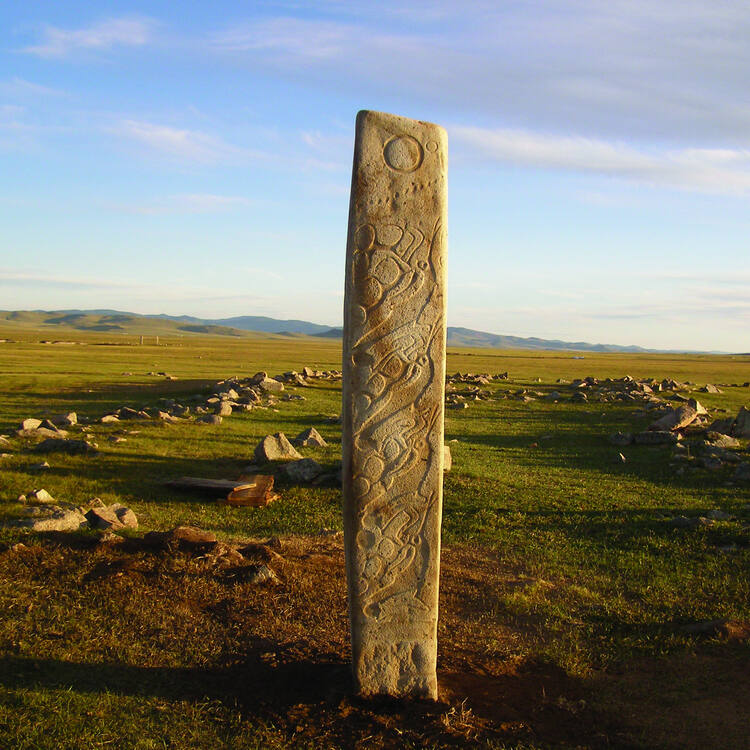Deer Stone Monuments and Related Bronze Age Sites
Deer Stone Monuments and Related Bronze Age Sites
Description is available under license CC-BY-SA IGO 3.0
Monuments des pierres à cerfs et sites associés de l’âge du bronze
Description is available under license CC-BY-SA IGO 3.0
معالم أحجار الغزلان والمواقع ذات الصلة من العصر البرونزي
source: UNESCO/CPE
Description is available under license CC-BY-SA IGO 3.0
鹿石遗迹以及相关青铜时代遗址
source: UNESCO/CPE
Description is available under license CC-BY-SA IGO 3.0
Оленные камни и связанные с ними объекты бронзового века
source: UNESCO/CPE
Description is available under license CC-BY-SA IGO 3.0
Monumentos de piedras de ciervo y sitios conexos de la Edad del Bronce
source: UNESCO/CPE
Description is available under license CC-BY-SA IGO 3.0
Outstanding Universal Value
Brief synthesis
The Deer Stone Monuments and Related Sites are significant and striking examples associated with the Late Bronze Age culture of Eurasian nomadic peoples. Deer stone monuments dated from approximately 1200 to 600 BCE. They are almost always located within complexes that include khirgisüürs (elaborated burial mounds), sacrificial altars, human burials and remains of horses, and other elements. Together the four component parts represent the occurrence and diversity of Mongolian deer stone monuments, khirgisüürs and satellite structures, and are notable examples of the world's megalithic ceremonial and funeral sites. Deer stones are gigantic steles, ranging in height up to four metres with engravings of stylised stag images. Elaborately decorated the stones are set directly in the ground singly or in groups.
In terms of ornamentation, cultural significance, archaeological and landscape contexts, the Mongolian deer stones are unique within the world’s Bronze Age monumental heritage sites. About 1,500 deer stones have been discovered across the Eurasian steppe, classified into three distinct forms based on their artistic traditions. More than eighty percent of these occur in Mongolia, and the images of a stylised stag that cover these stones are without parallels across Bronze Age Eurasia. The significance of deer stone complexes at Khoid Tamir, Jargalantyn Am, Urtyn Bulag and Uushigiin Övör lies not only in their ancient origins and broad distribution, but also in their number, the variety and elegance of their ornamentation, and their intact spatial associations with khirgisüürs and other elements.
Criterion (i): The Deer Stone Monuments are of exceptional beauty and cultural significance and are masterworks of Late Bronze Age culture. They constitute an outstanding example of Bronze Age megalithic monumental art of the highest quality, demonstrating the artistic vitality and creative genius of human achievement in prehistoric times. They demonstrate an extraordinary variety in their ornamentation, yet all featuring the imagery of a great antlered stag.
Criterion (iii): The Deer Stone Monuments and Related Sites provide an exceptional testimony to the culture of Eurasian Bronze Age nomads, which had evolved and disappeared slowly from the 2nd to the 1st millennia BCE. In their landscape settings, they are testimony to the ceremonial and funeral practices of these peoples.
Integrity
The serial property includes all the elements necessary to express its Outstanding Universal Value, and the selection of component parts has been justified. The elements within the four component parts reflect the original layout and size of the complexes as they were shaped in the Late Bronze and Early Iron Ages. Aside from some tourism facilities, there are no commercial activities associated with the property. The individual component parts and the serial property as a whole meet the requirements of integrity.
Authenticity
Archaeological studies support the truthfulness of cultural values attributed to the sites within the property. The component parts reflect the original form, design, materials, layout, size, and locations of these complex monuments as they were created and shaped in the Late Bronze and Early Iron Ages. Surviving vestiges and monuments attest to the artistic skills and techniques used in the creation of these complex structures, and the knowledge and talent of the people who built them.
Protection and management requirements
Legal protection is provided through the Mongolian Law on the Protection of Cultural Heritage (2014) and the List of Immovable Historical and Cultural Heritage Properties under State, Provincial and Local (Soum) Protection (2008). Protection applies to the four component parts via various provincial and local proclamations and lists. Khoid Tamir and Uushigiin Övör are included in the State list, while Jargalantyn Am and Urtyn Bulag are in provincial and local lists. Uushigiin Övör is also a monument under State Special Protection.
All component parts derive some protection from their remote locations and their traditional land use by nomadic herders. For the most part, such traditional ways of protection are still observed within these areas.
A concise management plan establishes a shared set of objectives for the four component parts. This has been elaborated with the active participation of local communities and stakeholders. A site management administration unit for the protection and management of World Heritage properties which will ensure the implementation of the integrated management plan has been established. There are a number of aspects of the management system that require continuing development and implementation including documentation, risk management, sustainable tourism planning and monitoring.
